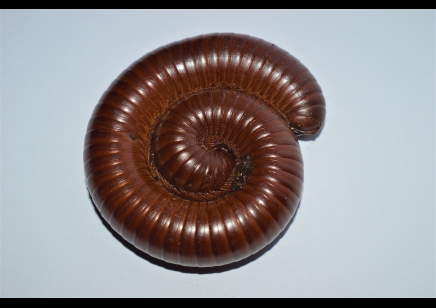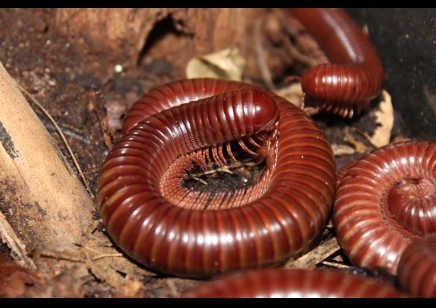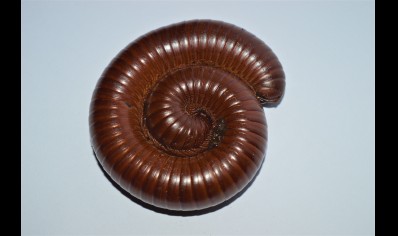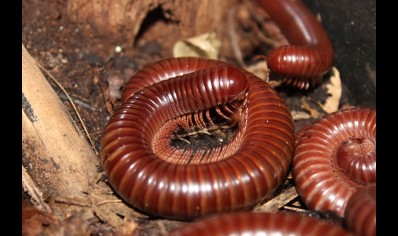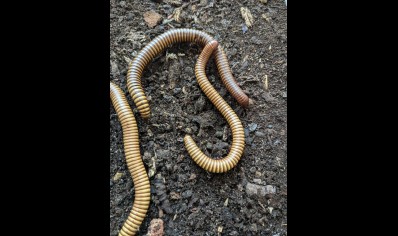Millipedes: Ophistreptus guineensis - African Giant Chocolate millipede *special discount*
Ophistreptus guineensis (SILVESTRI, 1897)
Astunning larger species growing to 26cm long, with a suberb shiny reddish tan colouration throughout.
The Chocolate millipede is more drought tolerant than its relatives, however it still feeds on moist, rotting mulch and wood. Millipede mouthparts are not tough enough to chew on hard surfaces, even with this species’ large size, so maintaining humidity to keep providing them with access to food is important.
Taxonomic Classification
- Kingdom: Animalia
- Phylum: Arthropoda
- Class: Diplopoda
- Order: Spirostreptida
- Family: Spirosteptidae
- Sub Family:
- Genus: Ophistreptus
- Species: guineensis
Order Now!
Minimum order £10 + Postal Charges
All payments are made through a secure payments system click here for more information.
0.5 - 4cm
£0.00
Out of Stock
4 - 8cm
£0.00
Out of Stock
8- 12cm
£5.00
Out of Stock
12 - 16cm
£6.00
Out of Stock
Care Sheet
HOUSING
Needs a large vivarium at least 60cm x 20cm x 50cm, with at least 10cm of moist to the touch substrate. Provide thick branches for the millipede to climb on as they will climb. They are very strong so make sure the lid/doors are locked down. Also likes to burrow into a deep substrate.
Must have cross ventilation to avoid any mould build up.
SUBSTRATE
Substrate can be made by combining the following:
50% humus :
This is the top 1" or so of humus found under a deciduous tree, and is basically a layer of sediment created from broken down leaves from several years ago mulched into a thick layer of humus. You can collect this from your local woods....under no circumstances can you use anything from pine trees.
20% last years leaves :
This is the fallen leaves from last year which are brown and part broken down.
20% shredded decaying wood
Use deciduous wood that crumbles easily between your fingers.
5% Playpit sand or bird grit/sand
ordinary shop bought play pit sand from any decent hardware store (DO NOT use builders sand), or grit/sand sold for use with pet birds.
5% ground cuttlefish bone or powdered garden limestone
either shred a cuttlefish bone with a sharp knife, or buy ground limestone which you can find in any large garden centre.
Mix all the ingredients together in the quantities suggested and then you have your substrate mix.
Lay about 7 to 8 cm of the mix in the bottom of the vivarium and tamp it down so that it is a little compacted, the make up to 10 to 12 cm with the rest of the mix, lightly tamped down.
TEMPERATURE AND HUMIDITY
Ambient temperature of 22 to 28 degrees.
DO NOT use heat mats under the substrate under any circumstances.
Relative humidity 70 to 80 degrees.
FEEDING
The millipede will feed on the constituents of the substrate, but will also take many fruits and vegetables. Particular favourites are:
cucumber,
melon,
banana,
cooked sweetcorn,
oranges.
REPRODUCTION
Males and females will readily mate in captivity and will often deposit eggs, often needing an arid stage and then a wet stage which should stimulate egg laying.
Males can be identified easily as the legs on the 7th segment are replaced by gonopods. Mating is conducted face to face, the pair often remaining coupled for long periods.
The young should be left with the adults as they will often feed on the fecal pellets of the adults, giving them the much needed bacteria contained therein.

